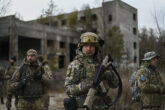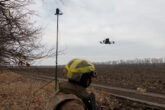November 07, 2017
The Sum of Their Fears: The MQ-25 Stingray
“Something is rotten in the state of Denmark,” sayeth the Bard in a line with ominous foreboding. Such potent can also be read into the decision that Northrop Grumman was dropping out of the competition for the navy’s MQ-25 unmanned tanker. Concerns have been rising since Naval Aviation’s issuance of a request for proposals (RFP) for the MQ-25 Stingray aircraft earlier this month. The description of what is to be the navy’s first unmanned aircraft to operate from a supercarrier, a mission tanker, seemed “off” or “fuzzy” in numerous ways, but the actual document itself so far has not been publicly available for review and hope remained that its contents would provide a path to continued relevance for both the carrier air wing and the supercarriers they flew from. However, Northrop’s decision, along with rumors that another major aviation company is also considering withdrawing, represent fears that the situation within U.S. Navy acquisitions is far from healthy. In fact, it seems we are in for a repeat of a situation that played itself out earlier this year.
The U.S. Navy, through Naval Air and Naval Sea Systems Command, had asked industry for a new long-range surface-to-surface missile. It appeared that the navy had been much impressed with the Raytheon partnered, Norwegian built, Kongsberg Naval Strike Missile after test firing it from the Littoral Combat Ship USS Coronado in 2014 and was looking towards that missile to gradually replace its aging supply of Harpoon missiles over the next decade. A sole source selection process was not followed and an open competition commenced with Raytheon-Kongsberg, Lockheed-Martin and Boeing emerging as competitors. Earlier this year, both Boeing and Lockheed suddenly dropped out of the surface-to-surface competition within days of each other, each citing concerns that the process did not fairly value their designs. Lockheed politely stated, as part of its withdrawal statement, “As the current OTH-WS request for proposal (RFP) process refined over time, it became clear that our offering would not be fully valued.” Boeing went further, bluntly stating that the navy had refined its requirements downward throughout the process, and that they “would have to take a lot of capability out of this existing system and really deliver a less-capable weapon system.”
Read the full op-ed in The National Interest.
More from CNAS
-
Defense / Transatlantic Security
When Defense Becomes Destruction: Austria-Hungary’s Mistake and Ukraine’s RiskThis article was originally posted on War on the Rocks. The southeastern Polish city of Przemyśl, with its elegant 19th century Habsburg-era train station, remains one of the ...
By Franz-Stefan Gady
-
Defense / Transatlantic Security
Ukraine’s Catch-22 MomentThis article was originally published in the Financial Times. In Joseph Heller’s wartime classic, Catch-22, the protagonist Yossarian seeks out the US army surgeon Doc Daneeka...
By Franz-Stefan Gady
-
CNAS Insights | Budgetary Own Goals Undermine “Speed and Volume”
On November 7, Secretary of Defense Pete Hegseth laid out a plan to overhaul the Department of Defense’s (DOD’s) acquisition system. Placing an emphasis on delivering new capa...
By Philip Sheers, Carlton Haelig & Stacie Pettyjohn
-
Drones: Who Is Making the New Weapons of War?
From Ukraine and Russia to Gaza and Sudan, drones have become a key weapon of war. Which companies are making them, and profiting from this rapidly expanding but controversial...
By Stacie Pettyjohn




